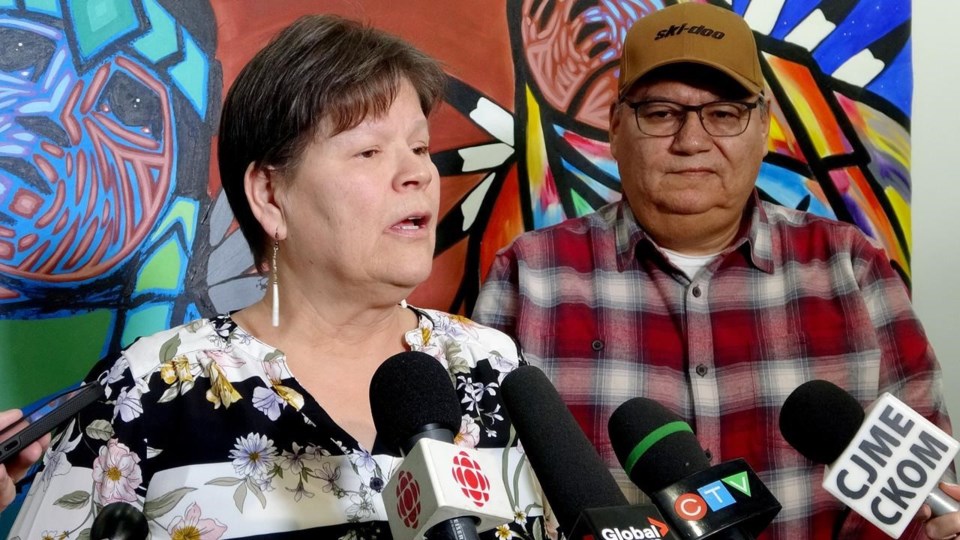MELFORT, Sask. — Members of a Saskatchewan First Nation who provided support after a mass stabbing say a coroner's inquest should be hearing about their response.
Cindy Ghostkeeper-Whitehead said she'll never forget the call she received early on Sept. 4, 2022, that something terrible was unfolding on the James Smith Cree Nation.
Myles Sanderson, 32, killed 11 people and injured 17 others there, and in the nearby village of Weldon, during a stabbing rampage. Sanderson died in police custody a few days later.
One of the people killed, Gloria Lydia Burns, was a crisis worker who had been called to a home to help another victim.
Ghostkeeper-Whitehead, a family wellness worker on the First Nation, said she went to check on her colleague and found out Burns had died. Ghostkeeper-Whitehead stayed by her body until family could arrive.
The inquest, now in its second week in Melfort, Sask., is to establish the events leading up to the killings, who died, and when and where each person was killed. The six-person jury can also come up with recommendations to prevent similar deaths.
A separate inquest into Sanderson's death is scheduled for February.
RCMP said in an overview of the massacre that Sanderson went to the First Nation to sell cocaine. In the days before the killings, he caused chaos with his brother, Damien Sanderson.
Damien Sanderson was the first to be killed. Myles Sanderson then went door to door on the First Nation, stabbing and killing people. An RCMP criminal profiler has testified that some victims were targeted because Sanderson had a grievance against them, and others just got in the way of his mission to kill.
Ghostkeeper-Whitehead said when she learned Earl Burns Sr. had died, the extent of the tragedy became clear.
"I realized what was happening, that we had lost all these members in our community," Ghostkeeper-Whitehead said Tuesday during a break in the inquest testimony.
Along with her husband, Ghostkeeper-Whitehead said she went to each home where a person was killed to offer wellness support to family members on the day of the rampage.
The first week of the coroner's inquest heard from the first RCMP officers who responded to the scene, as well as a criminal psychologist and profiler. On Monday, the inquest heard how paramedics and hospitals responded to the stabbings.
Mike Marion, the First Nation's health director, said it's frustrating the inquest is only hearing the third-party response to the tragedy. There's no mention of the First Nation’s first responders, he said.
"We had first aid members that were responding to give CPR, looking after the survivors that were stabbed, getting them to the triage at the centre," Marion said. "And there's no mention of that."
Marion said they have also provided a lot of supports since the massacre, including a therapist for each separate family.
Ghostkeeper-Whitehead and Marion both say it would be important information for the development of any recommendations.
The inquest heard Tuesday about Sanderson's time behind bars. His criminal history included 59 convictions as an adult; 35 were for failing to appear in court.
Jessica Diks, who was Sanderson's institutional parole officer in the federal penitentiary in Prince Albert, Sask., said Sanderson was denied parole each time he applied.
Sanderson was engaged in programs during his time at the penitentiary. When the COVID-19 pandemic hit, Sanderson became frustrated that it got in the way of his progress, Diks said. Sanderson could be very adversarial, she added.
"My impression was he didn't want to be told what to do."
Sanderson had asked to be released to the First Nation through a Section 84 process, which allows Indigenous offenders to be supported by an Indigenous community during conditional release. A liaison connected with First Nation leadership in August 2020 to develop a community release plan.
The inquest heard that Chief Calvin Sanderson of Chakastaypasin Band, one of three communities that make up James Smith, indicated he approved of Myles Sanderson's return to the community but he must follow conditions and maintain his programs.
Diks said she had concerns about Sanderson's release to the First Nation because of his history of domestic violence and vicinity to his common-law partner, Vanessa Burns.
Vanessa Burns told the inquest last week about 14 years of abuse at the hands of Sanderson. She said Sanderson attacked her multiple times when she was pregnant.
Chief Calvin Sanderson told reporters after the inquest wrapped Tuesday that the discussion about the release plan included concerns over Myles Sanderson's return to the community. The chief added there weren't enough supports.
The chief said at that time nobody had a "crystal ball" to know what would happen.
Myles Sanderson eventually picked his father's home in Saskatoon as his release destination, the inquest heard. The chief said he was not updated further about Sanderson's release plans.
Sanderson received statutory release in August 2021 after his first federal prison sentence. Statutory release kicks in when an offender has served two-thirds of a prison sentence.
Four months later, he was found to have been lying about his living arrangements and his release was suspended. In February 2022, the parole board cancelled that suspension and Sanderson again received statutory release with a reprimand.
That May, he was deemed unlawfully at large.
Chief Calvin Sanderson said leadership would like to see an inquiry to follow the inquest, so the community could have more of its questions answered.
This report by The Canadian Press was first published Jan. 23, 2024.
Kelly Geraldine Malone, The Canadian Press

